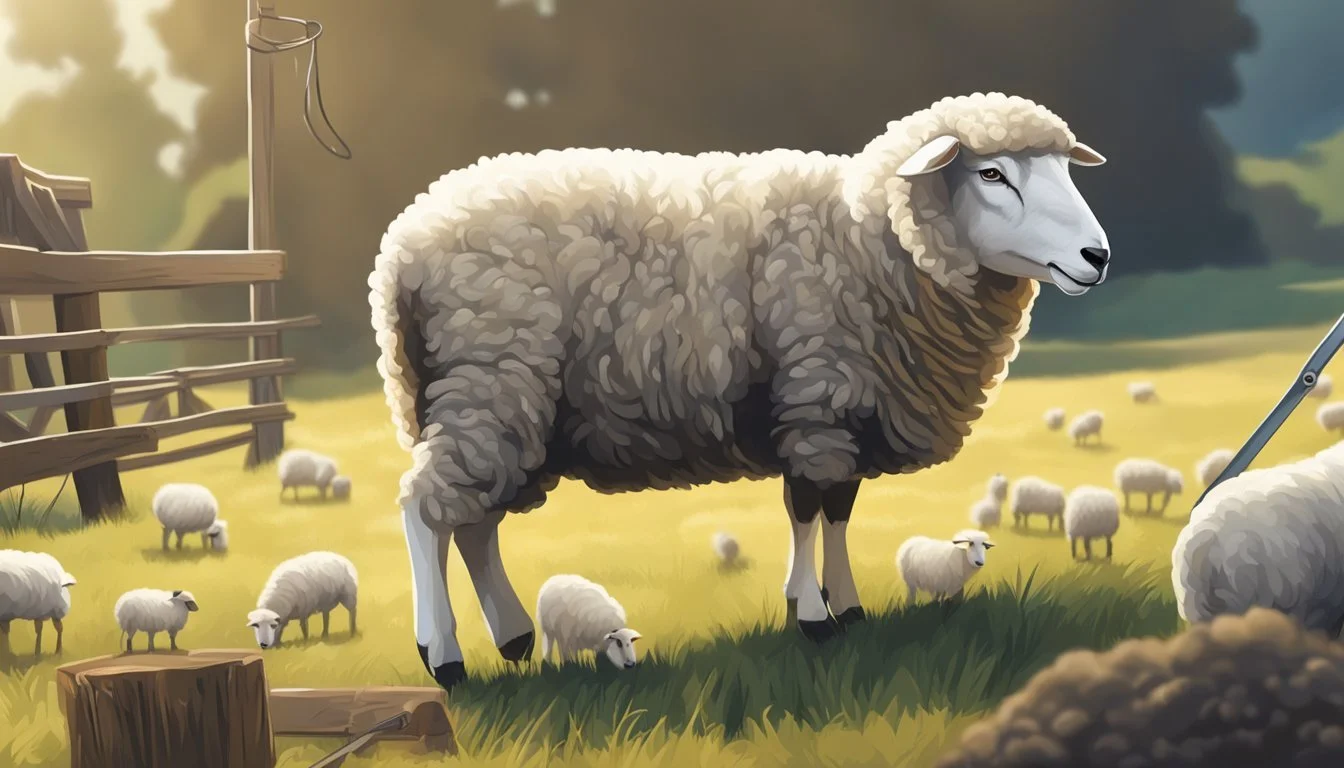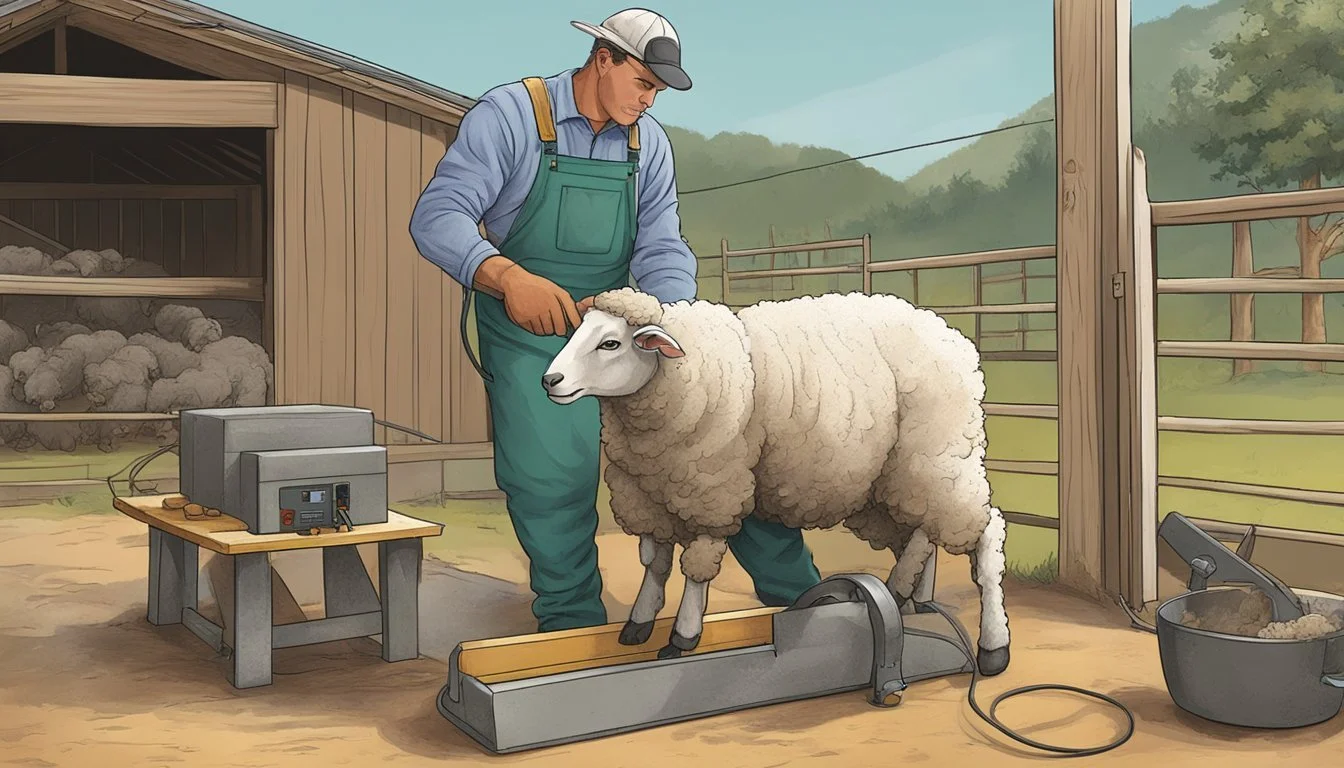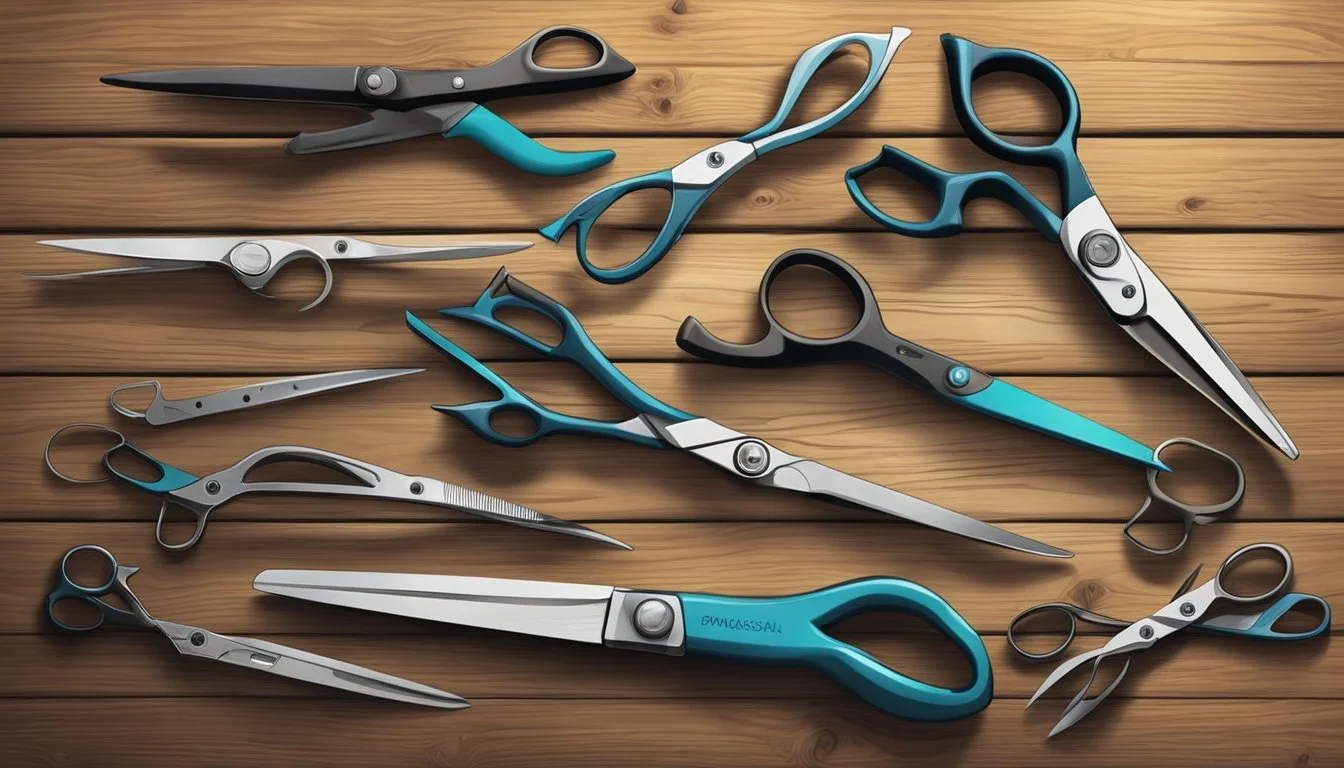The Best Electric Sheep Shears
Top Picks for Homestead Wool Harvesting
Shearing sheep is a vital part of sheep farming, ensuring the health of the sheep and the quality of the wool harvested. Quality electric sheep shears are essential tools for this task, designed for efficiency, speed, and the comfort of the animals. They come equipped with features like cooling mechanisms to prevent overheating, varying speeds to tackle different wool types, and ergonomic designs to reduce hand fatigue during extended shearing sessions.
Choosing the right electric sheep shears can be a challenge, with factors such as motor power, durability, and blade sharpness playing critical roles in performance. High-performing shears boast high power and speed, which allows for smooth cutting through dense wool, while also being durable enough to withstand the rigors of regular use. It is important to select shears that maintain their performance without causing discomfort to the sheep or the shearer.
For small homesteads or large farming operations alike, the goal is to find shears that deliver clean and precise cuts, minimizing stress for the sheep and ensuring a seamless shearing process. Whether the priority is on value, durability, or the ability to handle larger flocks, the market offers a range of shears to suit various shearing needs, reflecting advances in shearing technology and design.
Understanding Sheep Shearing
Sheep shearing is a critical agricultural practice that involves the removal of the wool fleece from sheep. It requires skill and understanding of both the equipment and the animal.
Basics of Shearing
Shearing is typically an annual activity that farmers perform to collect wool and ensure the sheep's health and hygiene. Key steps in the shearing process are:
Preparation: Gathering necessary equipment, ensuring blades are sharp.
Positioning: Handling sheep safely and effectively for both the sheep and the shearer.
Removal: Skilled shearers remove the fleece in one piece, avoiding injuries to the animal.
Post-Shearing Care: Looking after the sheep's skin health post-shear, checking for cuts or abrasions.
Significance of Efficient Wool Harvesting
Efficient wool harvesting benefits the animals and the farmers:
Animal Welfare: Proper shearing prevents overheating in sheep, reduces the risk of parasite infestation, and generally contributes to the overall well-being of the animal.
Quality Production: Efficient shearing practices result in high-quality fleece, which can impact the financial returns for farmers.
Resource Management: Effective shearing strategies utilize time and labor more efficiently, maximizing the profitability of wool harvesting within agricultural operations.
Choosing the Right Electric Sheep Shears
When homesteaders look to streamline their wool shearing process, selecting an electric sheep shears that balances power, precision, and comfort is crucial. These tools are an investment in the efficiency and sustainability of their livestock care practices.
Factors to Consider
Before making a purchase, it is essential for one to assess various aspects to find the right fit for their needs. The list below outlines the key factors to examine:
Size and Weight: The physical dimensions and heft of the shears affect maneuverability and fatigue during shearing. A lighter shear can reduce operator strain during extended use.
Power and Motor: The motor's strength, often measured in watts, dictates the shears' cutting efficacy. A powerful motor allows for continuous use without overheating and ensures smooth shearing even through dense wool.
Blade Quality: Sharp blades make for clean cuts and improved precision, which is not only better for the animal but also for the end product.
Performance: High strokes per minute (SPM) indicate a faster shearing action, leading to more efficient shearing sessions.
Comfort: An ergonomic design and features like anti-vibration technology help prevent user discomfort during operation.
Durability: The build quality of the shears determines how well they will stand up to regular use, making materials and construction key indicators of longevity.
Price: Cost is always a concern, and one must weigh it against the quality and features expected from the shears.
Precision: For precision work, variable speed controls allow the user to adjust the cutting speed for detail work around sensitive areas.
Types of Electric Shears
Two predominant types of electric shears cater to different shearing needs and scenarios:
Corded Electric Shears: These shears offer continuous power without the need for recharging but require proximity to an electrical outlet.
Pros: Consistent power supply, Generally more powerful
Cons: Restricted movement, Can be heavier due to the motor
Cordless Electric Shears: These provide greater freedom of movement and are often lighter, but their performance is limited by battery life.
Pros: Mobility without cords, Often lighter
Cons: Limited by battery duration, May lack the power of corded options
Each type comes with its own set of advantages and trade-offs, making it important for the user to consider their specific needs, such as the size of the flock and the shearing environment, when choosing between them.
Key Features of Top Electric Sheep Shears
Selecting the right electric sheep shears is crucial for an efficient and comfortable shearing experience. Top-quality shears typically feature a powerful motor, sharp blades with heat resistance, and are designed for easy handling to ensure comfort and efficiency.
Power and Motor Specifications
The motor's power is a vital aspect of electric sheep shears. High-quality shears often boast a powerful motor, with many models having a copper motor for improved longevity and performance. A common specification is a motor ranging from 350W to 500W, allowing for both precision and strength during shearing. Adjustable speeds are also important, enabling users to adapt the shears to the task at hand and the condition of the wool.
Motor Power Range: 350W - 500W
Adjustable Speeds: Typically 0 - 2,600 RPM
Blade Quality and Options
The blade is the point of contact with the sheep and therefore, its quality is non-negotiable. Shears should have sharp blades that are also heat resistant to prevent overheating during extended use. Look for models offering various blade options, which can help shepherds efficiently shear different wool types or perform detailed clipping.
Heat Resistance: High heat resistance for continuous use
Blade Options: Availability of multiple blade types for various shearing needs
Handling and Usability
Comfort and control during shearing are largely determined by the shears' design. Quality electric sheep shears are often ergonomically shaped and balanced for ease of use, reducing the strain on the user's hands and wrists. Furthermore, durable materials and a design that permits easy cleaning and maintenance contribute greatly to the tool’s overall usability.
Ergonomics: Designed for comfort and reduced hand strain
Maintenance: Easy to clean and maintain for lasting efficiency
Product Reviews
Choosing the right electric sheep shears can significantly impact the efficiency of wool shearing. The following reviews provide specific product details and performance insights to assist in making an informed decision.
Premier 4000c
The Premier 4000c electric sheep shears are known for their durability and ease of handling. These shears are designed to cater to the needs of both experienced shepherds and beginners. They offer robust performance and are priced in the mid to higher range, reflecting their quality.
Product Details:
Motor Power: High
Speed: Adjustable
Performance:
The Premier 4000c excels at delivering clean cuts with minimal fuss, making them a suitable option for those with larger flocks.
Beetro Electric Sheep Shears
Beetro Electric Sheep Shears stand out for their versatility and user-friendly interface. Though not as well-known as some other brands, Beetro's performance is commendable, especially at its price point which is generally lower than more premium models.
Product Details:
Motor Power: Moderate
Speed: Multiple settings
Performance:
With several speed options, the Beetro shears work well for detailed shearing tasks and can handle various wool types efficiently.
Oster Shearmaster Single-Speed Electric Sheep Shears
The Oster Shearmaster Single-Speed Electric Sheep Shears are a classic and highly reliable choice. Their build quality is exceptional, and while they may be more expensive, consumers get professional-grade shearing tools trusted by many in the industry.
Product Details:
Motor Power: Strong
Speed: Single-Speed
Performance:
These shears are known for their unwavering performance and are capable of handling the most challenging shearing sessions, proving their value over time.
Usage and Maintenance Tips
High-quality electric sheep shears are essential for efficient wool shearing. Ensuring their longevity and optimal performance requires consistent maintenance and adherence to operational best practices.
Operational Best Practices
When shearing sheep, shepherds should always follow the manufacturer's guidelines for their specific shears. Key practices include:
Proper Tension Adjustment: For optimal cutting, adjust the tension of the blades according to the thickness of the fleece.
Lubrication: Oiling the clipper head before, during, and after use is crucial. It reduces friction, heat, and wear on the blades.
Cooling: Use a cooling spray as a proactive measure to prevent the shears from overheating during extended use.
Safety: Exercise caution to avoid injury to both the animal and the operator. Avoid forcing the shears through the wool, which may harm the shears or cause discomfort to the animal.
Care and Cleaning
Regular care and cleaning ensure the shears remain in good working condition and extend their service life. Maintenance should include:
Air Filter Screen: Clean regularly to prevent buildup that can hamper ventilation and cooling.
Internal Gears: Apply grease to the internal gears occasionally to maintain smooth operation.
Blade Care: After usage, remove the blades to clean and lubricate them separately. This also helps to prevent rust.
By following these guidelines, shepherds can maintain their electric shearing equipment effectively, ensuring efficient and safe wool shearing sessions on their homesteads.
Safety Considerations for Shearing
When shearing sheep, an operator's safety is paramount. Using electric sheep shears requires an understanding of both how to prevent injuries and the features that enhance safety during use.
Preventing Injuries
Shearers must exercise caution to avoid cuts and other injuries. It is important to ensure that both the shearer and the animal are in a stable position before beginning. Proper technique and handling reduce the risk of slips and accidental contact with the shears. Additionally, regular breaks help to prevent fatigue, a common cause of accidents in shearing sheds.
Wear protective clothing such as shearing moccasins to avoid slipping.
Use sheep stands or supports to maintain sheep stability.
Keep equipment well-maintained to ensure clean cuts and reduce the need for excessive force.
Understanding Shear Features for Safety
Safe shears incorporate several features that are designed to protect the operator. Heat resistance is one essential aspect; shears should not overheat to a degree that risks burns to the operator or discomfort to the animal. Shears also come with various safety features, such as guards or automatic shut-offs, which help to prevent accidental injuries.
Look for shears with vented heads or cooling mechanisms to manage heat buildup.
Consider shears that have a safety switch or lock to prevent unintended operation.
Ensure that the shears have adjustable speeds to match the operator's skill level and shearing needs.
Alternative Shearing Equipment
Within the realm of wool shearing, farmers have a variety of tools at their disposal beyond electric shears. This section discusses the nuances between manual and electric options as well as the valuable additions that can enhance the shearing process.
Manual vs Electric Shears
Manual shears are the traditional choice for wool shearing. They require no power source and offer simplicity and precision, making them ideal for small jobs or detail work. Key differences include:
Force Required: Manual shears necessitate more physical effort from the user.
Precision: They provide greater control for careful shearing around sensitive areas.
Electric shears, on the other hand, are designed for efficiency and speed, suitable for shearing multiple animals or large flocks. They are characterized by:
Speed: Their cutting strokes per minute greatly exceed that of manual shears.
Ease: Electric shears reduce the physical exertion needed, decreasing operator fatigue.
Manual Shears: Force Required - High, Precision - High, Speed - Low, Ease of Use - Moderate
Electric Shears: Force Required - Low, Precision - Moderate, Speed - High, Ease of Use - High
Accessories and Add-Ons
Accessories can substantially augment the shearing experience. A durable toolbox, for instance, is critical for protecting shears and keeping them well-organized. It should be solid enough to withstand the rigors of farm work.
An accessory kit can include items such as lubricating oil, cleaning brushes, and replacement parts, which are essential for maintaining shears in optimal condition. It ensures longevity and peak performance of the equipment.
Here's a brief look at accessory types and their purpose:
Lubricating Oil: Essential for smooth operation and preventing overheating.
Cleaning Brushes: Used to maintain cleanliness and functionality after use.
Replacement Parts: Having spare parts on hand, such as blades or batteries for electric shears, ensures that shearing is not interrupted by equipment failure.
By selecting the right combination of shears and their accompanying accessories, farmers can tailor their shearing equipment to fit the specific needs of their homestead and flock.
Cost Analysis and Budgeting
Investing in the right electric sheep shears is crucial for efficient wool shearing but also requires careful cost consideration. The financial aspects to evaluate include the initial price of the shears, their longevity, and the potential for return on investment tehy can provide.
High-End Shears vs Affordable Options
High-end sheep shears typically offer more robust motors that operate at higher speeds, advanced cooling systems, and durable builds. They can handle larger flocks and extensive shearing work with more ease, but come with a higher upfront cost. Affordable shears, on the other hand, are priced lower and may be sufficient for smaller flocks, but may not have the longevity or efficiency of their more expensive counterparts.
Example: A high-end shear might operate at 3,000 strokes per minute and cost over $300, while an affordable option may offer 2,500 strokes per minute for around $100 to $200.
Calculating Return on Investment
To calculate return on investment (ROI), one needs to consider the cost of the shears in relation to the efficient workload they can handle over their lifetime. A more expensive shear that leads to faster shearing times and less downtime can result in higher wool production and perhaps justify the initial expenditure.
Calculating ROI:
(Total Revenue from Increased Production - Cost of Shears) / Cost of Shears
Example Calculation: If an expensive shear costing $300 increases production by $400 over its lifetime compared to using cheaper shears, the ROI would be: (400 - 300) / 300 = 0.33 or 33%
This shows a positive ROI, meaning the more expensive shears indeed paid off over time.
Choosing Shears for Different Animals
Selecting the right electric shears is crucial for efficient shearing and the animal's well-being. The tool should be appropriate for the species' coat type and size.
Shears for Sheep and Goats
For sheep shearing, wide-toothed blade sets are typically used to handle coarse wool without clogging. A high-power electric shear ranging from 300W to 500W ensures a smooth shearing process even with dense wool. Farmers might prefer shears with variable speed controls, allowing for a more customized experience suited to the fleece and the shearer's skill level.
When it comes to goats, because their hair can be finer and they often have sensitive skin, look for shears that offer sharpness without sacrificing the comfort to the animals' skin. Slightly lower power might suffice, ranging from 250W to 350W, allowing for precision without overheating.
Options for Alpaca, Llamas, and Other Livestock
Alpacas and llamas require a different approach due to their fiber's unique characteristics. Shears for these animals should combine a delicate touch with effectiveness, offering sharpness and a speed that doesn't cause the animal discomfort or stress.
Other types of livestock and even some pets may benefit from shearers designed for sheep or goats, but consider the weight and ease of use of the shears, especially for animals not used to shearing. The shears should not be as heavy-duty as those used for sheep, and a more ergonomic design can make the process easier for both the animal and the user. Padding and noise-reduction features are a bonus, as they reduce the stress on pets.







